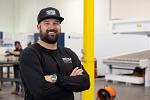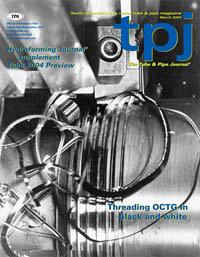Contributing Writer
- FMA
- The Fabricator
- FABTECH
- Canadian Metalworking
Categories
- Additive Manufacturing
- Aluminum Welding
- Arc Welding
- Assembly and Joining
- Automation and Robotics
- Bending and Forming
- Consumables
- Cutting and Weld Prep
- Electric Vehicles
- En Español
- Finishing
- Hydroforming
- Laser Cutting
- Laser Welding
- Machining
- Manufacturing Software
- Materials Handling
- Metals/Materials
- Oxyfuel Cutting
- Plasma Cutting
- Power Tools
- Punching and Other Holemaking
- Roll Forming
- Safety
- Sawing
- Shearing
- Shop Management
- Testing and Measuring
- Tube and Pipe Fabrication
- Tube and Pipe Production
- Waterjet Cutting
Industry Directory
Webcasts
Podcasts
FAB 40
Advertise
Subscribe
Account Login
Search
Developments in hydroforming
International conference highlights new equipment, industry trends
- By Dr. Stefan Wagner
- March 25, 2004
- Article
- Hydroforming
 |
The demand for hydroformed products continues to grow around the world, and so does the demand for hydroforming knowledge. To serve the continuing need for such knowledge, the third International Conference on Hydroforming brought people from around the world to Stuttgart, Germany, Oct. 28 and 29, 2003. The conference was organized under the chairmanship of Dr. h.c. Klaus Siegert, director of the Institut fr Umformtechnik (IFU), or Institute for Metal Forming Technology, at the University of Stuttgart.
The participants—400 in all—came from Europe, the U.S., and the Far East to learn about the latest developments and state-of-the-art technology used for internal high-pressure (IHP) forming, or tube hydroforming, and sheet hydroforming. Approximately 80 percent of the participants came from industry and the remaining 20 percent from universities and other research facilities.
Activities at the IFU
On the eve of the conference, participants had an opportunity to take part in a traditional open house at the IFU, where current research activities were demonstrated. Nearly 250 people attended the open house. One of the highlights was a newly built, 2,000-ton hydraulic press for sheet hydroforming. This press demonstrated hydromechanical deep drawing of outer panels for the engine hood of the BMW Z3® and the front fender of the Volvo S80®. Other presentations were based on research projects involving tube and sheet hydroforming, as well as process combinations.
 |
| IFU Director Klaus Siegert provided the opening remarks for the third International Conference on Hydroforming held Oct. 28-29 in Stuttgart, Germany. |
An Evolving Industry. In his opening remarks, Siegert commented on the current hydroforming climate: "It appears to be somewhat different for the third International Confer-ence on Hydroforming [compared to the second International Conference on Hydroforming in 2001], although there is still great interest. The market for hydroformed products is still growing, but more lightweight products, such as aluminum extrusions and aluminum sheet metal components, are now of interest to the automotive industry. Components made from steel tubes formed by internal high pressure are of interest mainly for lightweight trucks. The demand for hydromechanical deep-drawn sheet metal components for private cars is associated with the increase in production of niche and sports cars. Many new products from tubes, extrusions, and sheet metal have been optimized in order to reduce cycle time and investment. Furthermore, a lot of experience has been gained in the calculation and design of presses and dies.
"There are, however, still problems in achieving the demanded accuracy in the calculation and design of dies, taking into account the elastic deformation of the die and the springback behavior of the product. Breakdown of dies and presses has to be avoided. In any case, this is not typical for hydroforming, but it can happen in cases of incorrect calculation."
Tube Hydroforming Slowing, Sheet Hydroforming Growing. Trent Maki of Amino Corp., Fujinomiya, Japan, compared the state of tube and sheet hydroforming in North America, the Far East, and Europe: "I think that tube hydroforming is in a steady state now with no new real growth. Japan and Asia have been slow to incorporate this technology due to the large investment in tooling and equipment required, but we will see a steady but slow increase. The really new, fast-growing process, from Amino's point of view, is sheet hydroforming. This technology has been used in Japan for over 10 years and is in a steady state of growth, but the North American market is the one to watch. Starting in early 2005, our facility in Ontario, Canada, will be used to produce body panels. Our indications show that once the process is established in North America, it will take off exponentially. Our thinking is that there is an increasing desire in North America to build short-run, niche vehicles, and this fits well with the sheet hydroforming process. Although it will not be as big a business as tube hydroforming, we feel that it will still be significant."
 |
| Conference attendees had an opportunity to participate in an open house on the first evening of the event. |
During the conference, more than 20 companies participated in the accompanying exhibition in the foyer of the conference center. As part of this exhibition, ThyssenKrupp Steel AG, Duisburg, Germany, presented an innovative body concept with considerable potential for weight reduction, called the NewSteelBody (NSB®). The NSB combines the advantages of innovative profile design with elements of the classic shell design using modern multiphase steels. Using new design approaches, the company improved crash performance compared to reference vehicles, with a weight reduction of 24 percent. The main goal of NSB was to highlight realistic possibilities for weight reduction in conjunction with high-volume vehicle production.
Regarding future trends in the use of high-strength tubes, Dr.Franz-Josef Lenze of ThyssenKrupp Steel AG, explained that already about 37 percent of the NSB consists of tubes, about 17 percent of which are manufactured from thin-walled Thyssen tailored tubes. These tubes then are formed as parts with many integrated functions by IHP forming. High-strength steels, such as dual-phase steels, are stronger and stiffer than conventional materials, so less material can be used, which reduces the part's weight. Hydroforming at elevated temperatures remains, according to Lenze, restricted to certain applications because of the limited use of liquid media. The economics of the various competing metal forming processes, technical feasibility aside, will be the main criterion when considering using hydroforming or a conventional forming technology.
Asked for his opinion about future trends in sheet hydroforming, Dr. Matthias Aust of ThyssenKrupp Drauz GmbH, Heilbronn, Germany, said that to date, despite known quality, cost, and process advantages, there are few series applications. Two main reasons for this are press efficiency and emergency or disaster recovery strategies. If one of the few presses available on the market fails, there is a risk that the supply of parts for the production of a car body shell cannot be sustained. This risk is too great because these parts, even in small-volume production, are mostly for exclusive vehicles.
In Japan, hydromechanical deep drawing has been used efficiently and economically in series applications for decades. Examples for current applications are fenders, roofs, and hoods. Aust thinks this is due to differences between European and Japanese press builders regarding development status and the resulting cycle time.
 |
| Hydroformed automobile panels and other components were displayed at the IFU. |
Furthermore, Aust pointed out that currently intensive efforts are being made to produce complex parts from high-strength steels by warm forming. The experience in this area indicates that this technology will not be used for producing niche cars but for high-volume car production. This technology is not comparable to conventional deep drawing, so a great amount of research and development work is needed to check each single forming operation by finite element modeling (FEM), including the tool design, the preliminary processes, and the reproducibility of process control. In addition, job safety requirements have to be taken into account.
Simulating Hydroforming
All presentations demonstrated that the FEM process simulation is a useful tool for developing hydroforming processes. This was confirmed by professor Pavel Hora of the Institute of Virtual Manufacturing at the Eidgenssische Technische Hochschule (ETH), Zurich, Switzerland. He pointed out that IHP processes, especially those using thin-walled tubes, generally can be modeled satisfactorily with modern FEM tools. Virtual modeling thick-walled tubes or extrusions with complex cross sections is more difficult. FE simulation of the tube bending process also is ambitious, and the calculations are time-consuming, mainly because of the complex contact conditions that arise, for example, from bending tube with an inner mandrel. The difficulty is in determining material parameters.
Regarding future developments, Hora said that there is no special need for the development of IHP-specific FE codes. Future developments in virtual process design are certain to be, as they were for other forming processes, the automated process optimization and the potential to evaluate process robustness by means of stochastic simulation methods.
Dr. Stefan Wagner is chief engineer at the Institute for Metal Forming Technology (IFU) of the University of Stuttgart, Holzgartenstrae 17, D-70174 Stuttgart, Germany, +49-711-121-3852, fax +49-711-121-3839, wagner@ifu.uni-stuttgart.de, www.ifu-stuttgart.de.
About the Author
About the Publication
subscribe now

The Tube and Pipe Journal became the first magazine dedicated to serving the metal tube and pipe industry in 1990. Today, it remains the only North American publication devoted to this industry, and it has become the most trusted source of information for tube and pipe professionals.
start your free subscription- Stay connected from anywhere

Easily access valuable industry resources now with full access to the digital edition of The Fabricator.

Easily access valuable industry resources now with full access to the digital edition of The Welder.

Easily access valuable industry resources now with full access to the digital edition of The Tube and Pipe Journal.
- Podcasting
- Podcast:
- The Fabricator Podcast
- Published:
- 04/16/2024
- Running Time:
- 63:29
In this episode of The Fabricator Podcast, Caleb Chamberlain, co-founder and CEO of OSH Cut, discusses his company’s...
- Trending Articles
Fabricator achieves extraordinary with simple approach

Team Industries names director of advanced technology and manufacturing

New trails, old-school values for Precision Tube Laser

Orbital tube welding webinar to be held April 23

Blades designed for cutting medium metals

- Industry Events
16th Annual Safety Conference
- April 30 - May 1, 2024
- Elgin,
Pipe and Tube Conference
- May 21 - 22, 2024
- Omaha, NE
World-Class Roll Forming Workshop
- June 5 - 6, 2024
- Louisville, KY
Advanced Laser Application Workshop
- June 25 - 27, 2024
- Novi, MI


























